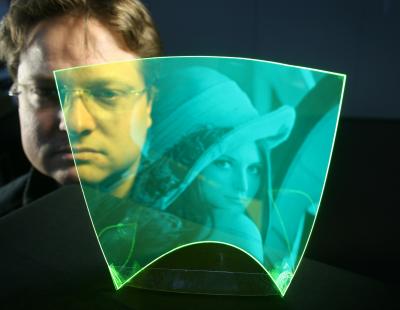If I read this correctly, the big selling point for UBC’s flexible, wearable display screen is energy efficiency. From a July 10, 2023 University of British Columbia (UBC) news release on EurekAlert,
Imagine a wearable patch that tracks your vital signs through changes in the colour display, or shipping labels that light up to indicate changes in temperature or sterility of food items.
These are among the potential uses for a new flexible display created by UBC researchers and announced recently in ACS Applied Materials and Interfaces.
“This device is capable of fast, realtime and reversible colour change,” says researcher Claire Preston, who developed the device as part of her master’s in electrical and computer engineering at UBC. “It can stretch up to 30 per cent without losing performance. It uses a colour-changing technology that can be used for visual monitoring. And it is relatively cheap to manufacture.”
Previous attempts at creating stretchable displays have involved complex designs and materials, limiting their stretchability and optical quality. In this new research, scientists leaned on electrochromic displays—which are able to reversibly change colour, while requiring low power consumption—to overcome these limitations. [emphasis mine]
“We used PEDOT:PSS, an electrochromic material that consists of a conductive polymer combined with an ionic liquid, resulting in a stretchable electrode that acts as both the electrochromic element and the ion storage layer. This simplifies the device’s architecture and eliminates the need for a separate stretchable conductor,” says Ms. Preston.
The display is transparent and feels like a stiff rubber band. To support the thin layers of PEDOT and allow them to elongate without breaking, the team added a solid polymer electrolyte and a stretchable encapsulation material called styrene-ethylene-butylene-styrene (SEBS).
“The potential uses for this stretchable display are significant. It could be integrated into wearable devices for biometric monitoring, allowing for real-time visual feedback on vital signs. The displays could also be used in robotic skin, enabling robots to display information and interact more intuitively with humans,” noted senior author Dr. John Madden, a professor of electrical and computer engineering who supervised the work.
Additionally, the low power consumption and cost-effectiveness of this technology make it attractive for use in disposable applications such as indicator patches for medical purposes or smart packaging labels for sensitive shipments. It could also be used to actively change the colour of jackets, hats and other garments.
“While there is need for more work to integrate this device into everyday devices, this breakthrough brings us one step closer to a future where flexible and stretchable displays are a common part of our daily lives,” Dr. Madden added.
Here’s a link to and a citation for the paper,
Intrinsically Stretchable Integrated Passive Matrix Electrochromic Display Using PEDOT:PSS Ionic Liquid Composite by Claire Preston, Yuta Dobashi, Ngoc Tan Nguyen, Mirza Saquib Sarwar, Daniel Jun, Cédric Plesse, Xavier Sallenave, Frédéric Vidal, Pierre-Henri Aubert, and John D. W. Madden. ACS Appl. Mater. Interfaces 2023, 15, 23, 28288–28299 DOI: https://doi.org/10.1021/acsami.3c02902 Publication Date: June 5, 2023 Copyright © 2023 The Authors. Published by American Chemical Society
This paper is open access.
